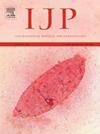揭示血孢子虫寄生虫(血孢子虫科、血孢子虫属)的外红细胞发育模式,以及自然感染鸟类的组织阶段流产案例。
IF 3.2
2区 医学
Q1 PARASITOLOGY
引用次数: 0
摘要
血蛋白虫(Haemosporida,Haemoproteidae)是一种影响鸟类健康的世界性血液寄生虫。基于分子标记应用的最新发现表明,血包虫的外红细胞阶段或组织阶段会损害包括大脑在内的各种内脏器官。然而,大多数已描述物种的外红细胞发育模式仍不清楚。本研究旨在了解血蛋白寄生虫在自然感染的鸫夜莺(鹟科)中的外红细胞发育过程。通过显微镜检查和基于 PCR 的方法确认了 8 只鸟类的感染情况。使用组织学和原位杂交法对器官进行了检查,原位杂交法使用了针对寄生虫 18S rRNA 的属特异性和系特异性寡核苷酸探针。首次在这一禽类宿主体内发现并描述了减毒血单胞菌(血系 hROBIN1)的外红细胞经虫。大多数子囊虫出现在肺部,少数出现在肝脏、心脏和胸肌。现有数据表明,这种寄生虫只产生美拉隆子,而不产生巨型美拉隆子。不过,在一个个体的胗和心脏中观察到了大量处于不同发育阶段的巨核细胞。根据巨核细胞的形态、在器官中的位置以及使用血系特异性探针进行的诊断,这些巨核细胞被认为是 Haemoproteu smajoris(血系 hWW2)。在胗中发现两例巨核细胞的空囊壁,表明巨核细胞已经破裂和退化。大量的显微镜检查没有发现大肠杆菌的配子细胞,这显然表明大肠杆菌的发育已经中止。人们经常推测野生动物中会出现血孢子虫感染,但在自然感染的鸟类中还没有记录。这项研究确认了 H. attenuatus 的外红细胞发育模式,据我们所知,这是首次记录自然感染的鸟类在外红外发育过程中出现血孢子虫感染流产的情况。本文章由计算机程序翻译,如有差异,请以英文原文为准。

Unravelling the patterns of exo-erythrocytic development of Haemoproteus parasites (Haemoproteidae, Haemosporida), with a case of abortive tissue stages in a naturally infected bird
Haemoproteus species (Haemosporida, Haemoproteidae) are cosmopolitan blood parasites that affect bird fitness and health. Recent discoveries based on the application of molecular markers showed that exo-erythrocytic or tissue stages of haemoproteids damage various internal organs including the brain. However, the patterns of exo-erythrocytic development remain unclear for most of the described species. This study aimed to understand the exo-erythrocytic development of Haemoproteus parasites in naturally infected Thrush nightingales Luscinia luscinia (Muscicapidae). Infections were confirmed in eight bird individuals by microscopic examination and PCR-based methods. Organs were examined using histology and in situ hybridization, which applied genus-specific and lineage-specific oligonucleotide probes targeting the 18S rRNA of the parasites. Exo-erythrocytic meronts of Haemoproteus attenuatus (lineage hROBIN1) were found and described for the first known time in this avian host. Most meronts were seen in the lungs, with a few also present in the liver, heart, and pectoral muscle. The available data suggest that this parasite produces only meronts, and not megalomeronts. However, numerous megalomeronts at different stages of development were observed in the gizzard and the heart of one individual. Based on the morphology, location in organs, and diagnostics using the lineage-specific probes, the megalomeronts were attributed to Haemoproteus majoris (lineage hWW2). Two cases of empty capsular-like walls of megalomeronts were seen in the gizzard, indicating that the megalomeronts had already ruptured and degenerated. The extensive microscopic examination did not reveal gametocytes of H. majoris, obviously indicating an abortive development. Abortive haemosporidian infections were often speculated to occur in wildlife but have not been documented in naturally infected birds. This study recognised patterns in the exo-erythrocytic development of H. attenuatus, and is to our knowledge the first documentation of abortive Haemoproteus infection in a naturally infected bird during exo-erythrocytic development.
求助全文
通过发布文献求助,成功后即可免费获取论文全文。
去求助
来源期刊
CiteScore
8.40
自引率
2.50%
发文量
76
审稿时长
23 days
期刊介绍:
International Journal for Parasitology offers authors the option to sponsor nonsubscriber access to their articles on Elsevier electronic publishing platforms. For more information please view our Sponsored Articles page. The International Journal for Parasitology publishes the results of original research in all aspects of basic and applied parasitology, including all the fields covered by its Specialist Editors, and ranging from parasites and host-parasite relationships of intrinsic biological interest to those of social and economic importance in human and veterinary medicine and agriculture.

 求助内容:
求助内容: 应助结果提醒方式:
应助结果提醒方式:


